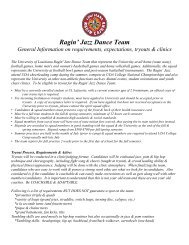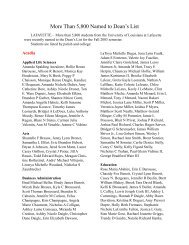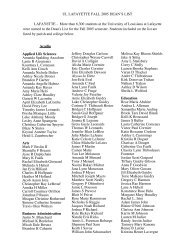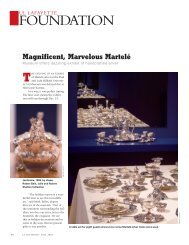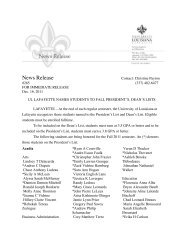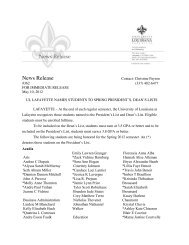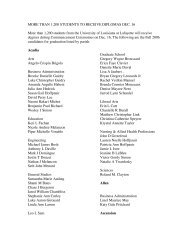22 la louisiane | spring 2010 - University of Louisiana at Lafayette
22 la louisiane | spring 2010 - University of Louisiana at Lafayette
22 la louisiane | spring 2010 - University of Louisiana at Lafayette
You also want an ePaper? Increase the reach of your titles
YUMPU automatically turns print PDFs into web optimized ePapers that Google loves.
<strong>22</strong> LA LOUISIANE | SPRING <strong>2010</strong>
the world’s appetite for energy continues to expand.<br />
and while demand for oil and n<strong>at</strong>ural gas isn’t likely to<br />
wane any time soon, there’s also a growing hunger for<br />
energy sources th<strong>at</strong> are renewable and eco-friendly.<br />
a team <strong>of</strong> ul <strong>la</strong>fayette experts is exploring some<br />
intriguing altern<strong>at</strong>ives to fossil fuels.<br />
By Sarah Spell<br />
photography By Doug DugaS<br />
Dr. Barbara Benson leans forward, taking a closer look <strong>at</strong> a tabletop aquarium<br />
in an engineering <strong>la</strong>b in UL <strong>Lafayette</strong>’s Madison Hall. • To the untrained eye,<br />
the tank filled with olive green slime may look like a science experiment run<br />
amok. To Benson, the algae growing inside are a beautiful sight. In the murky<br />
w<strong>at</strong>er, she sees a source <strong>of</strong> renewable energy. • Benson is an assistant pr<strong>of</strong>essor<br />
<strong>of</strong> environmental science in the Department <strong>of</strong> Renewable Resources. She is<br />
part <strong>of</strong> UL <strong>Lafayette</strong>’s Bioprocessing Research Labor<strong>at</strong>ory, a multidisciplinary<br />
effort involving more than 20 faculty members from the College <strong>of</strong> Engineering,<br />
the Ray P. Authement College <strong>of</strong> Sciences and the B.I. Moody III College <strong>of</strong><br />
Business Administr<strong>at</strong>ion. The engineers, chemists, biologists, economists and left: Dried, crushed algae.<br />
opposite page: Vaughn hulin, a<br />
the students who study with them, are investig<strong>at</strong>ing altern<strong>at</strong>ives to petroleum-<br />
freshman chemical engineering<br />
based fuels. • The Bioprocessing Research Labor<strong>at</strong>ory encompasses several fa-<br />
student, takes a sample from<br />
cilities across campus where experiments are under way to unlock power from a a 10-liter biodiesel reactor in a<br />
variety <strong>of</strong> m<strong>at</strong>erials, from algae to allig<strong>at</strong>or f<strong>at</strong>, from sweet pot<strong>at</strong>oes to sausages. Madison hall <strong>la</strong>b.<br />
LA LOUISIANE | SPRING <strong>2010</strong> 23
Bi<strong>of</strong>uels<br />
Glossary<br />
bi<strong>of</strong>uel: fuel made from renewable<br />
biological resources<br />
biodiesel: liquid fuel produced by<br />
the separ<strong>at</strong>ion <strong>of</strong> f<strong>at</strong>s and glycerin<br />
in biological m<strong>at</strong>erial. It can be<br />
used in diesel engines.<br />
biomass: biological source m<strong>at</strong>erial.<br />
Biomass can include but is<br />
not limited to wood; grasses and<br />
woody p<strong>la</strong>nts; food crops; animal<br />
parts; algae; and the organic components<br />
<strong>of</strong> municipal and industrial<br />
waste.<br />
energy crops: agricultural crops<br />
grown specifically for their energy<br />
value<br />
ethanol: liquid fuel produced from<br />
the ferment<strong>at</strong>ion <strong>of</strong> sugar th<strong>at</strong> can<br />
be used in gasoline engines<br />
feedstock: biological m<strong>at</strong>erial<br />
used in the cre<strong>at</strong>ion <strong>of</strong> a particu<strong>la</strong>r<br />
bi<strong>of</strong>uel<br />
gasific<strong>at</strong>ion: he<strong>at</strong> process used<br />
to convert carbon-based m<strong>at</strong>erials<br />
into a gas th<strong>at</strong> contains carbon<br />
monoxide, carbon dioxide and<br />
hydrogen<br />
green diesel: liquid fuel derived<br />
from biomass. unlike biodiesel,<br />
green diesel is comp<strong>at</strong>ible with<br />
exisiting petroleum industry infrastructure.<br />
syngas: synthesis gas; gas produced<br />
from biomass through the<br />
gasific<strong>at</strong>ion process. Syngas can<br />
be used to produce liquid fuels,<br />
including ethanol and green diesel,<br />
as well as other chemicals and<br />
products, such as biodegradable<br />
p<strong>la</strong>stics.<br />
transesterific<strong>at</strong>ion: the chemical<br />
process in which alcohol reacts<br />
with trigylcerides in vegetable oil<br />
or animal f<strong>at</strong>s, separ<strong>at</strong>ing the glycerin<br />
and producing biodiesel<br />
24 LA LOUISIANE | SPRING <strong>2010</strong><br />
DR. MARk ZAPPI,<br />
dean <strong>of</strong> the College<br />
<strong>of</strong> Engineering<br />
and leader <strong>of</strong> the research<br />
team, describes<br />
the quest for altern<strong>at</strong>ive<br />
energy as a “horse<br />
race” <strong>of</strong> competing<br />
technologies. “It’s<br />
too early to tell how<br />
th<strong>at</strong> race will end. So,<br />
we’re spreading our<br />
bets, col<strong>la</strong>bor<strong>at</strong>ing on<br />
several possible solutions,”<br />
he said.<br />
When Zappi was<br />
named dean in 2005,<br />
he was well-qualified<br />
to establish high-level bi<strong>of</strong>uels<br />
research. He earned a bachelor’s<br />
degree in civil engineering from<br />
UL <strong>Lafayette</strong> and then began<br />
more than a decade <strong>of</strong> work as<br />
an environmental engineer <strong>at</strong> the<br />
U.S. Army Corps <strong>of</strong> Engineers’<br />
W<strong>at</strong>erways Experiment St<strong>at</strong>ion<br />
in Vicksburg, Miss. While<br />
WESTERN U.S.<br />
Lake Charles<br />
Production <strong>of</strong> power<br />
from waste wood chips<br />
Production <strong>of</strong> power<br />
from biogas <strong>at</strong> poultry<br />
oper<strong>at</strong>ions<br />
Production <strong>of</strong> biodiesel<br />
from algal oil<br />
MEXICO<br />
Bunkie<br />
Ville P<strong>la</strong>tte<br />
Opelousas<br />
Crowley<br />
working there, he<br />
completed master’s<br />
and doctoral degrees<br />
in chemical engineering<br />
<strong>at</strong> Mississippi St<strong>at</strong>e<br />
<strong>University</strong>. In 1995,<br />
he began his academic<br />
career <strong>at</strong> MSU.<br />
While <strong>at</strong> MSU,<br />
Zappi conducted<br />
research, taught c<strong>la</strong>sses<br />
and was director <strong>of</strong> the<br />
Mississippi <strong>University</strong><br />
Research Consortium<br />
for the Utiliz<strong>at</strong>ion <strong>of</strong><br />
Biomass and director<br />
<strong>of</strong> the MSU Environmental<br />
Technology Research Labor<strong>at</strong>ory. During his career,<br />
he’s helped secure $30 million for projects ranging from<br />
basic technology research and development to industrial<br />
economic development.<br />
He serves as an advisor to several Mississippi companies<br />
involved with bi<strong>of</strong>uels and bioproduct development.<br />
At MSU, Zappi and other scientists cre<strong>at</strong>ed a manure<br />
biorefinery on a poultry farm in south Mississippi to<br />
conduct to research poultry litter as a power source. The<br />
biorefinery on the 1,000-acre farm transforms chicken<br />
Dr. Mark Zappi, Dean <strong>of</strong> the College <strong>of</strong><br />
engineering<br />
louisiana’s reGional advantaGes<br />
& potential enerGy sources<br />
LOUISIANA<br />
NORTH LOUISIANA<br />
Production <strong>of</strong><br />
ethanol from<br />
switch grass<br />
ACADIANA ALTERNATIVE<br />
ENERGY REGIONAL<br />
PARTNERSHIP<br />
<strong>Lafayette</strong><br />
Abbeville<br />
New Iberia<br />
GULF COAST<br />
INSHORE AND<br />
OFFSHORE<br />
Morgan City<br />
NORTH SEA<br />
B<strong>at</strong>on Rouge<br />
AFRICA<br />
Houma<br />
Production <strong>of</strong> possible<br />
energy from so<strong>la</strong>r cells<br />
Production <strong>of</strong> ethanol<br />
from sugar cane<br />
Gulf <strong>of</strong> Mexico<br />
LEGEND<br />
GLOBAL DRILLING<br />
OPERATIONS<br />
Potential altern<strong>at</strong>ive<br />
energy sources<br />
ACADIANA ALTERNATIVE<br />
ENERGY REGIONAL<br />
PARTNERSHIP<br />
Slidell<br />
New Orleans<br />
Production <strong>of</strong> power<br />
from river<br />
hydro-turbines<br />
Grand Isle<br />
acadiana is an intern<strong>at</strong>ional hub <strong>of</strong> the oil-and-gas industry. Its infrastructure and shipping<br />
capabilities could be used to produce and distribute altern<strong>at</strong>ive energy.
Dr. Barbara Benson, assistant pr<strong>of</strong>essor <strong>of</strong> environmental science, and chemical<br />
engineering gradu<strong>at</strong>e student harry Daultani inocu<strong>la</strong>te a bioreactor tank with algae.<br />
litter into a methane-rich biogas, which is then used to<br />
gener<strong>at</strong>e electricity. Solids and liquids left over from the<br />
process can be used as fertilizer.<br />
“To see a project like th<strong>at</strong> move from idea to reality<br />
is extremely rewarding. But wh<strong>at</strong>’s more exciting is th<strong>at</strong> it<br />
shows the potential for bi<strong>of</strong>uels research in general,” he said.<br />
ZAPPI SAID UL LAfAyETTE RESEARCHERS ARE “REthinking<br />
and rebuilding” <strong>Louisiana</strong>’s energy industry.<br />
“<strong>Louisiana</strong> is well-positioned to make an economic<br />
and industrial transition to bi<strong>of</strong>uels. We have the<br />
infrastructure and industry already in p<strong>la</strong>ce, along with<br />
research capabilities.”<br />
UL <strong>Lafayette</strong> is a member <strong>of</strong> the st<strong>at</strong>ewide Clean<br />
Power and Energy Research Consortium, which includes<br />
Tu<strong>la</strong>ne <strong>University</strong>, <strong>Louisiana</strong> St<strong>at</strong>e <strong>University</strong>, Nicholls<br />
St<strong>at</strong>e <strong>University</strong>, Southern <strong>University</strong>, the <strong>University</strong> <strong>of</strong><br />
New Orleans and the LSU AgCenter. The consortium supports<br />
interdisciplinary research to improve existing energy<br />
technology and to explore altern<strong>at</strong>ive energy sources.<br />
“Petroleum is a finite resource,” Zappi said. “Expert<br />
opinions differ as to when petroleum supplies will be<br />
depleted but I think the economics <strong>of</strong> petroleum will<br />
p<strong>la</strong>y out before the world actually runs out <strong>of</strong> petroleum.<br />
There will be an economic shift toward renewable fuels.<br />
We’re preparing for th<strong>at</strong> shift by conducting a broad<br />
range <strong>of</strong> research.”<br />
He points to a number<br />
<strong>of</strong> indic<strong>at</strong>ors th<strong>at</strong> suggest<br />
th<strong>at</strong> shift may already have<br />
started. for instance, the<br />
Obama administr<strong>at</strong>ion’s<br />
economic stimulus bill,<br />
signed into <strong>la</strong>w in february,<br />
has earmarked billions <strong>of</strong><br />
dol<strong>la</strong>rs for grants, tax credits<br />
and investments in clean<br />
energy development and<br />
training. And, noted Zappi,<br />
“oil and gas companies are<br />
redefining themselves as<br />
energy companies.” Last<br />
year, Exxon Mobil announced<br />
it would invest<br />
$600 million to produce<br />
fuel from algae. Chevron<br />
and Weyerhaeuser have a<br />
partnership to develop bi<strong>of</strong>uels<br />
from wood waste.<br />
Non-toxic and<br />
components <strong>of</strong> a<br />
successful Bi<strong>of</strong>uel<br />
industry<br />
Renewable Feedstocks<br />
long-term avai<strong>la</strong>bility<br />
Chemical stability<br />
Suitable <strong>la</strong>nd<br />
Resource Collection<br />
harvesting<br />
Storage and handling<br />
transport<strong>at</strong>ion<br />
Product Conversion<br />
processing and waste management<br />
potential to cre<strong>at</strong>e secondary products<br />
pr<strong>of</strong>it analysis<br />
Product Distribution/Usage<br />
Market development<br />
price<br />
product performance<br />
biodegradable, bi<strong>of</strong>uels can be made from any biomass, or<br />
biological source. Two <strong>of</strong> the most promising options are<br />
LA LOUISIANE | SPRING <strong>2010</strong> 25
Judith adewusi, a chemical<br />
engineering gradu<strong>at</strong>e student,<br />
compares the amount <strong>of</strong> oil<br />
produced by yeast grown on rice<br />
versus yeast grown on sweet<br />
pot<strong>at</strong>oes.<br />
ethanol and biodiesel. Consumers<br />
are likely familiar with ethanol,<br />
which is <strong>of</strong>ten blended into gasoline<br />
<strong>at</strong> the pump. Ethanol is an alcohol,<br />
but it is also a hydrocarbon, which<br />
sweet Pot<strong>at</strong>oes<br />
makes it comp<strong>at</strong>ible with gasoline.<br />
Ethanol can be made from<br />
three types <strong>of</strong> feedstock: sugars, starches and cellulosic,<br />
or p<strong>la</strong>nt, m<strong>at</strong>erial. Brazil, the world’s <strong>la</strong>rgest exporter <strong>of</strong><br />
ethanol, produces the fuel from sugar cane. In the United<br />
St<strong>at</strong>es, corn has been the staple ingredient in ethanol.<br />
Unlike sugar cane, corn requires an additional process-<br />
26 LA LOUISIANE | SPRING <strong>2010</strong><br />
‘there wIll Be an eConoMIC ShIft<br />
towarD renewaBle fuelS. we’re<br />
preparIng for th<strong>at</strong> ShIft By<br />
ConDuCtIng a BroaD range <strong>of</strong><br />
reSearCh.’<br />
Dr. Mark ZappI, Dean <strong>of</strong> the College <strong>of</strong> engIneerIng<br />
ing step <strong>of</strong> ferment<strong>at</strong>ion – to convert<br />
the cornstarch into sugar – before it can<br />
become fuel.<br />
“There’s <strong>at</strong> least one other drawback,<br />
Zappi said. “Using corn as a<br />
feedstock has really spurred the foodversus-fuel<br />
deb<strong>at</strong>e.”<br />
<strong>Louisiana</strong> moved away from cornbased<br />
ethanol in 2008 with the cre<strong>at</strong>ion<br />
<strong>of</strong> the Advanced Bi<strong>of</strong>uel Industry<br />
Initi<strong>at</strong>ive, signed into <strong>la</strong>w by Gov.<br />
Bobby Jindal. The legis<strong>la</strong>tion cre<strong>at</strong>ed a<br />
pilot program th<strong>at</strong> combines research,<br />
production and distribution <strong>of</strong> non-corn<br />
based ethanol.<br />
Zappi said the UL <strong>Lafayette</strong> team<br />
is exploring sources such as cultiv<strong>at</strong>ed<br />
p<strong>la</strong>nt m<strong>at</strong>erials and waste m<strong>at</strong>erials th<strong>at</strong><br />
don’t compete with food supply.<br />
P<strong>la</strong>nts can be cost-efficient to grow<br />
and harvest for biomass feedstock and<br />
can provide a desirable feedstock-to-fuel<br />
r<strong>at</strong>io. UL <strong>Lafayette</strong> researchers are also<br />
exploring the use <strong>of</strong> low-grade rice and<br />
waste sweet pot<strong>at</strong>oes to produce ethanol.<br />
RiCe<br />
Biodiesel is made from p<strong>la</strong>nt or animal oils through<br />
a chemical process called transesterific<strong>at</strong>ion, which transforms<br />
f<strong>at</strong>s into fuel. Green diesel, or renewable diesel, is<br />
made through c<strong>at</strong>alytic processing <strong>of</strong> the oils produced<br />
from biomass, a process th<strong>at</strong>’s simi<strong>la</strong>r to the traditional<br />
refining process for petroleum crude oils.<br />
Dr. Stephen Dufreche, an assistant pr<strong>of</strong>essor <strong>of</strong><br />
chemical engineering <strong>at</strong> UL <strong>Lafayette</strong>, said biodiesel is<br />
re<strong>la</strong>tively simple to make. “With the right equipment<br />
and m<strong>at</strong>erials, you could make it <strong>at</strong> home,” he said. In<br />
the engineering <strong>la</strong>b, researchers use a portable reactor to<br />
produce biodiesel.<br />
Th<strong>at</strong> fuel could go into a standard diesel engine, but<br />
might cause some problems, said Dufreche. The f<strong>at</strong>s congeal<br />
in cold temper<strong>at</strong>ures, changing the liquid fuel to a<br />
gel. And because biodiesel is a solvent, it will break down<br />
deposits <strong>of</strong> residue left by diesel, clogging fuel lines.<br />
Green diesel is chemically simi<strong>la</strong>r to traditional<br />
Continued on page 28
Technology enAbles reseArchers<br />
To see molecules in A new lighT<br />
An interdisciplinary team <strong>of</strong> top researchers <strong>at</strong> the <strong>University</strong><br />
<strong>of</strong> <strong>Louisiana</strong> <strong>at</strong> <strong>Lafayette</strong> is exploring a “green” way to use<br />
glycerol, a byproduct <strong>of</strong> biodiesel manufacturing.<br />
Its members are identifying and testing enzymes present in<br />
bacteria commonly found in soil. An enzyme is a protein th<strong>at</strong><br />
speeds up chemical processes. These scientists are working to develop<br />
enzymes th<strong>at</strong> are able to convert glycerol into compounds<br />
with much higher value for the chemical industry.<br />
They are harnessing the power <strong>of</strong> Zeke, UL <strong>Lafayette</strong>’s supercomputer,<br />
to make mind-boggling comput<strong>at</strong>ions and then convert<br />
these d<strong>at</strong>a into images<br />
th<strong>at</strong> can be examined<br />
using virtual reality <strong>at</strong><br />
the <strong>Louisiana</strong> Immersive<br />
Technologies Enterprise<br />
on campus.<br />
LITE is one <strong>of</strong> only<br />
a few public facilities<br />
th<strong>at</strong> combine highspeed<br />
networks and<br />
high-performance computing<br />
with 3-D visualiz<strong>at</strong>ion<br />
and immersive<br />
technologies.<br />
“So this enzyme<br />
project is an amazing<br />
confluence <strong>of</strong> brainpower,<br />
computer horsepower,<br />
comput<strong>at</strong>ional<br />
chemistry and advanced<br />
immersive visualiz<strong>at</strong>ion,” said Dr. Bradd C<strong>la</strong>rk, dean <strong>of</strong> the Ray P.<br />
Authement College <strong>of</strong> Sciences <strong>at</strong> UL <strong>Lafayette</strong>.<br />
As the volume <strong>of</strong> biodiesel, an altern<strong>at</strong>ive to fossil fuels, has<br />
increased dram<strong>at</strong>ically worldwide, the amount <strong>of</strong> glycerol produced<br />
has grown too. for every 10 pounds <strong>of</strong> biodiesel, about a pound <strong>of</strong><br />
glycerol is cre<strong>at</strong>ed. So glycerol is abundant and inexpensive but <strong>of</strong><br />
limited use.<br />
Dr. Rakesh k. Bajpai is a pr<strong>of</strong>essor <strong>of</strong> chemical engineering<br />
and holds UL <strong>Lafayette</strong>’s endowed chair in bioprocessing. He is also<br />
associ<strong>at</strong>e director <strong>of</strong> the Bioprocessing Research Labor<strong>at</strong>ory in the<br />
university’s College <strong>of</strong> Engineering.<br />
Using a chemically modified enzyme to convert glycerol would<br />
be a “green” altern<strong>at</strong>ive to chemical processes th<strong>at</strong> require more<br />
energy, Bajpai said. “Using this modified enzyme, we would not be<br />
producing anything harmful and we would reduce waste.”<br />
Enzyme development is <strong>of</strong> gre<strong>at</strong> interest in Europe and the<br />
United St<strong>at</strong>es. In 1994, a french group <strong>of</strong> scientists sequenced<br />
the gene <strong>of</strong> an enzyme th<strong>at</strong> was capable <strong>of</strong> converting glycerol.<br />
Last year, a p<strong>at</strong>ent was granted for improvements <strong>of</strong> the enzyme’s<br />
properties. When a p<strong>at</strong>ent is obtained, future work on th<strong>at</strong> enzyme<br />
becomes <strong>of</strong>f limits to other researchers.<br />
C<strong>la</strong>rk said Dr. Wu Xu, an associ<strong>at</strong>e pr<strong>of</strong>essor <strong>of</strong> biochemistry<br />
<strong>at</strong> UL <strong>Lafayette</strong>, is working to improve a different type <strong>of</strong> enzyme,<br />
one th<strong>at</strong> is even more efficient than the p<strong>at</strong>ented one.<br />
Xu has identified about 25 simi<strong>la</strong>r enzymes. However, testing<br />
each enzyme using traditional chemistry would be expensive<br />
and time consuming. So scientists <strong>at</strong> UL <strong>Lafayette</strong>’s Center for<br />
Advanced Computer Studies are using its supercomputer, Zeke, to<br />
come up with calcu<strong>la</strong>tions and visualiz<strong>at</strong>ions <strong>of</strong> enzymes ideal for<br />
glycerol conversion.<br />
Bajpai exp<strong>la</strong>ined th<strong>at</strong> enzymes fit chemical compounds “like<br />
a key in a lock.” The desired product <strong>of</strong> the enzyme is obtained<br />
when a w<strong>at</strong>er molecule is removed from glycerol. “If the glycerol<br />
fits exactly, the enzyme can unlock the w<strong>at</strong>er molecule. If it doesn’t<br />
m<strong>at</strong>ch up precisely, nothing<br />
will happen,” he said.<br />
Dr. Dipesh Bh<strong>at</strong>tarai<br />
and Si feng, UL <strong>Lafayette</strong><br />
research scientists,<br />
used the comput<strong>at</strong>ions <strong>of</strong><br />
Dr. yen-Shan Liu, a researcher<br />
in Dr. Wu’s <strong>la</strong>b,<br />
to develop 3-D images<br />
<strong>of</strong> the enzyme with the<br />
most potential.<br />
These enzyme molecules<br />
are <strong>la</strong>rge. Th<strong>at</strong> may<br />
seem like an oxymoron,<br />
but in the overall scheme<br />
<strong>of</strong> tiny particles th<strong>at</strong><br />
make up m<strong>at</strong>ter, enzyme<br />
molecules are giants.<br />
Some molecules are<br />
composed <strong>of</strong> only a few<br />
<strong>at</strong>oms. The enzymes th<strong>at</strong> the UL <strong>Lafayette</strong> team is studying are<br />
made up <strong>of</strong> about 15,000 <strong>at</strong>oms.<br />
The images can be disp<strong>la</strong>yed in The flex, an interactive 3-D<br />
immersive space in LITE th<strong>at</strong> has a three-projector curved screen,<br />
motion tracking and an immersive sound system. The researchers<br />
can add and subtract <strong>at</strong>oms; the images morph to illustr<strong>at</strong>e the new<br />
configur<strong>at</strong>ions.<br />
When viewed through special eyeg<strong>la</strong>sses, the images are threedimensional.<br />
“you actually feel like you can touch the molecule.<br />
Th<strong>at</strong>’s the exciting part,” Bh<strong>at</strong>tarai said.<br />
When the scientists find the virtual enzyme they want to<br />
produce in the <strong>la</strong>bor<strong>at</strong>ory, they will turn to another team member,<br />
Dr. Andrei Chistoserdov, an associ<strong>at</strong>e pr<strong>of</strong>essor <strong>of</strong> biology and microbiology,<br />
to genetically modify the bacteria so they will produce<br />
desired enzymes.<br />
LITE’s technology may be used in another enzyme-re<strong>la</strong>ted<br />
project. Dr. Stephen Dufreche, an assistant pr<strong>of</strong>essor <strong>of</strong> chemical<br />
engineering, is exploring the use <strong>of</strong> enzymes to cre<strong>at</strong>e trinitrotoluene,<br />
better known as TNT.<br />
Chemical processes have been used to make the explosive for<br />
the past 80 or 90 years. “But with those processes, we make an undesirable<br />
byproduct in environmentally unacceptable quantities,”<br />
Bajpai said. “We think th<strong>at</strong> if we can make it enzym<strong>at</strong>ically, we can<br />
make it in an environmentally safe manner.” n<br />
Dr. Dipesh Bh<strong>at</strong>tarai, left, and Si feng use the flex, an immersive visualiz<strong>at</strong>ion<br />
tool, to get a 3-D look <strong>at</strong> a glycerol dehydr<strong>at</strong>ase protein molecule.<br />
SI fENG<br />
LA LOUISIANE | SPRING <strong>2010</strong> 27
Feedstock<br />
Rice hulls<br />
Sugar cane<br />
bagasse<br />
Switchgrass<br />
Wood chips<br />
Continued from page 26<br />
Powerful PArTnershiP diesel, so it doesn’t present those<br />
An altern<strong>at</strong>ive energy production facility p<strong>la</strong>nned for Acadia Parish will provide UL<br />
faculty and students with research opportunities while gener<strong>at</strong>ing power for <strong>Louisiana</strong><br />
utility customers.<br />
Cleco Power LLC will build a $1.5 million gasifier on a five-acre site in Acadia Parish Industrial<br />
Park, adjacent to interst<strong>at</strong>e and rail transport<strong>at</strong>ion. The project is a partnership among<br />
Cleco, NorthStar Resources LLC, Acadia Parish and UL <strong>Lafayette</strong>’s College <strong>of</strong> Engineering.<br />
Construction is set to begin this summer.<br />
Dr. John Guillory, associ<strong>at</strong>e pr<strong>of</strong>essor and acting head <strong>of</strong> UL <strong>Lafayette</strong>’s Department <strong>of</strong> Mechanical<br />
Engineering, is the lead designer <strong>of</strong> the facility. He col<strong>la</strong>bor<strong>at</strong>ed with EDG Inc., an intern<strong>at</strong>ional<br />
engineering firm based in <strong>Louisiana</strong>.<br />
Dr. Mark Zappi, dean <strong>of</strong> UL Lafayettte’s College <strong>of</strong> Engineering said the gasifier will be a<br />
training facility where students learn to make fuels.<br />
“A gasifier can transform any combustible m<strong>at</strong>erial,” he exp<strong>la</strong>ined. M<strong>at</strong>erial is burned <strong>at</strong><br />
high temper<strong>at</strong>ures with low levels <strong>of</strong> oxygen. Instead <strong>of</strong> burning completely, the raw m<strong>at</strong>erial is<br />
converted into syngas, or synthesis gas, a mixture <strong>of</strong> hydrogen, carbon monoxide and carbon<br />
dioxide. Syngas can be processed further to gener<strong>at</strong>e electricity or cre<strong>at</strong>e liquid fuels or other<br />
chemical compounds.<br />
“We’re essentially ripping apart complex chemicals and reducing them to their building<br />
blocks. Then we can reassemble those chemicals into compounds we want to produce,”<br />
Zappi said.<br />
Students and faculty will explore the energy potential <strong>of</strong> rice hulls, sugar cane bagasse,<br />
poultry litter and sewage sludge. Researchers are also considering cultiv<strong>at</strong>ed energy crops,<br />
such as switchgrass, a perennial grass n<strong>at</strong>ive to <strong>Louisiana</strong>’s coastal prairie, and giant reed, a<br />
grass th<strong>at</strong> produces a bamboo-like stalk. The facility is designed to process three tons <strong>of</strong> m<strong>at</strong>erial<br />
each day.<br />
“UL <strong>Lafayette</strong> will be one <strong>of</strong> a few institutions to have access to a <strong>la</strong>rge-scale facility,” said<br />
Zappi. The facility will be a model for commercializ<strong>at</strong>ion <strong>of</strong> full-scale gasifiers. “It is designed<br />
exactly as an industrial facility, with all <strong>of</strong> the safety systems and protocols in p<strong>la</strong>ce,” he said.<br />
Ben Russo, director <strong>of</strong> market development for Cleco, said the research and development<br />
facility will help his company form long-range p<strong>la</strong>ns for investment in altern<strong>at</strong>ive energy.<br />
“We’ve been moving in this direction for about two years, but we still have lots <strong>of</strong> unanswered<br />
questions about wh<strong>at</strong> m<strong>at</strong>erials will work best and wh<strong>at</strong> the overall cost may be.<br />
“We want to look <strong>at</strong> a wide variety <strong>of</strong> renewable energy sources. Ultim<strong>at</strong>ely, the research<br />
conducted by the UL <strong>Lafayette</strong> group will help us determine a cost-benefit r<strong>at</strong>io for a variety <strong>of</strong><br />
m<strong>at</strong>erials. We want to know, for instance, how much energy we can produce from a ton <strong>of</strong> rice<br />
hulls or a ton <strong>of</strong> wood chips.” n<br />
Gasifier<br />
feedstock to fuel<br />
Syngas<br />
28 LA LOUISIANE | SPRING <strong>2010</strong><br />
C<strong>at</strong>alytic<br />
Conversion<br />
followed<br />
by refining<br />
for liquid<br />
fuels<br />
Electricity<br />
Diesel Fuel<br />
challenges. It remains fluid in cold<br />
temper<strong>at</strong>ures and can be used in<br />
existing industry infrastructure.<br />
It can be blended with diesel and<br />
produces lower emissions than<br />
traditional diesel.<br />
“Because <strong>of</strong> the obvious advantages,<br />
energy companies are moving<br />
away from investing in biodiesel<br />
development in favor <strong>of</strong> renewable<br />
diesel,” Dufreche said.<br />
UL <strong>Lafayette</strong> scientists are<br />
addressing two primary challenges<br />
in bi<strong>of</strong>uels research: developing<br />
high-yield feedstocks, or biological<br />
source m<strong>at</strong>erial, and cost-effective<br />
extraction and refining methods. (See<br />
re<strong>la</strong>ted article, page 27.)<br />
THE MOST DESIRABLE fEEDstocks<br />
for biodiesel contain<br />
high amounts <strong>of</strong> f<strong>at</strong>, which can be<br />
refined into fuel. Chinese tallow<br />
trees, for example, are “an almost<br />
perfect feedstock” for green diesel,<br />
Dufreche said. Th<strong>at</strong>’s because<br />
their white, waxy seeds yield <strong>la</strong>rge<br />
amounts <strong>of</strong> polys<strong>at</strong>ur<strong>at</strong>ed f<strong>at</strong>.<br />
“To produce renewable diesel,<br />
you have to introduce high levels <strong>of</strong><br />
hydrogen into the refining process.<br />
If you’re working with a highly s<strong>at</strong>ur<strong>at</strong>ed<br />
feedstock, it’s already full <strong>of</strong><br />
hydrogen to begin with,” he said.<br />
In addition to tallow trees,<br />
the UL <strong>Lafayette</strong> research team<br />
is analyzing allig<strong>at</strong>or f<strong>at</strong> as a fuel<br />
source, Dufreche said. “We can<br />
look <strong>at</strong> almost any oil as a basis for<br />
research. Wh<strong>at</strong> we want to know is:<br />
Can we develop technology to produce<br />
th<strong>at</strong> fuel in a way th<strong>at</strong> is both<br />
cost efficient and environmentally<br />
responsible?”<br />
lOUISIANA SWEET POTATOES MAy<br />
be a source <strong>of</strong> fuel, according<br />
to research under way in UL<br />
<strong>Lafayette</strong> <strong>la</strong>bor<strong>at</strong>ories. The work is<br />
being led by Dr. Rakesh k. Bajpai, a<br />
pr<strong>of</strong>essor <strong>of</strong> chemical engineering.<br />
Bajpai, who came to UL <strong>Lafayette</strong><br />
from the <strong>University</strong> <strong>of</strong> Missouri-<br />
Columbia, is an intern<strong>at</strong>ionally<br />
known bi<strong>of</strong>uels expert.<br />
S<strong>at</strong>ish P<strong>at</strong>il is a gradu<strong>at</strong>e<br />
student working in Bajpai’s <strong>la</strong>b.
“We are focusing<br />
on sweet pot<strong>at</strong>o<br />
starch because we<br />
are in <strong>Louisiana</strong>,<br />
partnering with<br />
local industry,”<br />
P<strong>at</strong>il said.<br />
Each fall, part<br />
<strong>of</strong> the crop is left<br />
in the field because<br />
it doesn’t measure<br />
up to food-<br />
Chinese tallow tRee<br />
grade standards.<br />
Researchers are<br />
using sweet pot<strong>at</strong>o<br />
waste — raw sweet<br />
pot<strong>at</strong>oes and sweet<br />
pot<strong>at</strong>o peels — as<br />
food for yeast.<br />
“The yeast<br />
we are using for<br />
our research has<br />
strong extracellu<strong>la</strong>r<br />
enzyme activity,<br />
which means it<br />
loUisiana allig<strong>at</strong>oR<br />
has the ability to<br />
break down the<br />
sweet pot<strong>at</strong>o starch and consume it,” P<strong>at</strong>il exp<strong>la</strong>ined. As<br />
the yeast, or fungi, feed on the starch, they produce oil.<br />
He measures the amounts <strong>of</strong> carbon and nitrogen as<br />
the ferment<strong>at</strong>ion process unfolds. As the yeast deplete the<br />
carbon in the starch, nitrogen levels rise. “As long as carbon<br />
is present, the yeast are multiplying. But when they<br />
LAfAyETTE CONVENTION & VISITORS COMMISSION<br />
top: Chemical engineering gradu<strong>at</strong>e student S<strong>at</strong>ish p<strong>at</strong>il takes a sample<br />
<strong>of</strong> algae grown under fluorescent light. p<strong>at</strong>il built the reactors, which<br />
are used in a Madison hall <strong>la</strong>bor<strong>at</strong>ory. above: Srividya aya<strong>la</strong>somayaju<strong>la</strong><br />
filters oil from allig<strong>at</strong>or f<strong>at</strong>.<br />
LA LOUISIANE | SPRING <strong>2010</strong> 29
Chemical engineering student Bridget Meaux measures<br />
the amount <strong>of</strong> methane being produced by fermenting<br />
sewage sludge.<br />
start feeding on nitrogen, the oil globules become bigger<br />
and bigger.”<br />
P<strong>at</strong>il is also exploring ways to extract the oil, including<br />
using ultrasonic waves to break open the cells, and using<br />
solvents to remove the oil through a chemical reaction.<br />
ZAPPI SAID WHEN RESEARCHERS CAN “TAkE SOMEthing<br />
out <strong>of</strong> the waste stream and convert it to energy,<br />
they know they’re on the right track. Waste disposal is<br />
<strong>of</strong>ten a major cost to industry. We can take th<strong>at</strong> waste and<br />
turn it into a product th<strong>at</strong> has value.”<br />
He and his team are taking samples <strong>of</strong> sewage sludge<br />
from the <strong>Lafayette</strong> Utilities System’s wastew<strong>at</strong>er tre<strong>at</strong>-<br />
30 LA LOUISIANE | SPRING <strong>2010</strong><br />
‘waSte DISpoSal IS <strong>of</strong>ten a<br />
MaJor CoSt to InDuStry. we Can<br />
take th<strong>at</strong> waSte anD turn It Into<br />
a proDuCt th<strong>at</strong> haS Value.’<br />
Dr. Mark ZappI, Dean <strong>of</strong> the College <strong>of</strong> engIneerIng<br />
ment p<strong>la</strong>nts<br />
to explore the<br />
potential to make<br />
fuels and other<br />
products. Oil<br />
can be harvested<br />
from the sludge<br />
for biodiesel or<br />
green diesel. The<br />
sludge can also<br />
be used as a fuel<br />
source in a gasifi-<br />
lUs wastew<strong>at</strong>eR PonD<br />
er, a facility th<strong>at</strong><br />
burns biological<br />
m<strong>at</strong>ter to produce synthesis gas, or syngas (See re<strong>la</strong>ted<br />
story on page 28 for more inform<strong>at</strong>ion.)<br />
Bridget Meaux, a chemical engineering undergradu<strong>at</strong>e,<br />
has conducted experiments to measure the amount <strong>of</strong><br />
methane produced by sewage sludge and other m<strong>at</strong>erials.<br />
To take those measurements, she uses a small bioreactor,<br />
a g<strong>la</strong>ss vial topped with an air-pressure gauge. “We<br />
built these bioreactors to find out how much gas is being<br />
produced. Wh<strong>at</strong>ever’s in there, it will release gas under<br />
airtight conditions,” she said. Bacteria digest the biological<br />
m<strong>at</strong>erial, producing methane.<br />
Meaux has worked with algae, sewage sludge and<br />
other ingredients. “We added chicken blood, old me<strong>at</strong>,<br />
chicken litter. It was disgusting, but it cre<strong>at</strong>ed more gas,”<br />
she observed.<br />
“We also added vitamin solutions to the reactors.<br />
Just as the function <strong>of</strong> a human body is improved and<br />
enhanced with vitamins, so are the bacteria’s.”<br />
oNE Of THE MOST PROMISING SOURCES Of ALTERn<strong>at</strong>ive<br />
fuel is algae. The microorganisms produce<br />
lipids, n<strong>at</strong>ural oils th<strong>at</strong> can be converted into biodiesel<br />
and green diesel.<br />
Dr. Barbara Benson said algae “don’t require much.<br />
They need sunlight and w<strong>at</strong>er, carbon dioxide and trace<br />
nutrients to grow.” They aren’t picky about w<strong>at</strong>er conditions<br />
either. Algae are found in saltw<strong>at</strong>er, freshw<strong>at</strong>er and<br />
brackish w<strong>at</strong>er.<br />
Benson and her students are cultiv<strong>at</strong>ing and evalu<strong>at</strong>ing<br />
multiple strains <strong>of</strong> algae, measuring and analyzing<br />
their growth r<strong>at</strong>es and levels <strong>of</strong> oil production.<br />
“I was originally interested in algae as a source <strong>of</strong><br />
pharmaceuticals and nutritional supplements. When<br />
I came to UL <strong>Lafayette</strong>, Dean Zappi steered me in the
sTuDenTs creATe vehicle for service leArning<br />
uL <strong>Lafayette</strong> students are preparing to hit the road to<br />
educ<strong>at</strong>e others about sustainable living. The RUNbus,<br />
a modified school bus, will serve as a mobile<br />
c<strong>la</strong>ssroom for demonstr<strong>at</strong>ions <strong>of</strong> clean energy, energy-efficient<br />
building str<strong>at</strong>egies and community-based food production.<br />
It will include se<strong>at</strong>ing, cooking and sleeping facilities, and a<br />
12-foot-square, foldout stage.<br />
UL <strong>Lafayette</strong> student Chance Gabehart organized the<br />
Resourceful <strong>University</strong> Network, a non-pr<strong>of</strong>it student group<br />
devoted to environmental awareness, in 2008. “We were looking<br />
for a fun way to network with other people with the same<br />
interests. During one <strong>of</strong> our meetings, someone suggested a<br />
bus th<strong>at</strong> could run on used cooking oil.”<br />
Gabehart purchased a used bus for $1,500 and don<strong>at</strong>ed<br />
it to the non-pr<strong>of</strong>it group. “We wrote three grants, none <strong>of</strong><br />
which were funded, but we learned a lot in the grant-writing<br />
process. It forced us to solidify our ideas,” he said. Gabehart<br />
is a senior majoring in general studies, with a focus on liberal<br />
arts and a minor in business.<br />
Dr. Barbara Benson, an assistant pr<strong>of</strong>essor <strong>of</strong> environmental<br />
science in the Department <strong>of</strong> Renewable Resources,<br />
became the group’s faculty liaison <strong>la</strong>st year. She wrote a successful<br />
$12,655 grant, funded by the <strong>University</strong> <strong>of</strong> <strong>Louisiana</strong><br />
System’s service learning program. RUN also has received<br />
more than $15,000 in don<strong>at</strong>ed m<strong>at</strong>ching contributions from<br />
community sponsors, Benson said.<br />
Students have been involved in every step <strong>of</strong> the process. More<br />
than 100 <strong>of</strong> them have contributed to the project. Some received<br />
course credit for designing components <strong>of</strong> the exhibition vehicle.<br />
“Industrial design students worked out the p<strong>la</strong>ns for the<br />
interior and the aesthetics <strong>of</strong> the exterior <strong>of</strong> the bus. Mechanical<br />
Sabine Lake<br />
Gulf <strong>of</strong> mexico dead Zone<br />
Lake Calcasieu<br />
Gulf <strong>of</strong> Mexico<br />
LOUISIANA<br />
Atchafa<strong>la</strong>ya River<br />
Terrebonne Bay<br />
direction <strong>of</strong> altern<strong>at</strong>ive fuels and I got real fired up about<br />
th<strong>at</strong>,” Benson said.<br />
She brings real-world experience to her c<strong>la</strong>ssroom<br />
and <strong>la</strong>bor<strong>at</strong>ory. In the 1980s, she worked for the <strong>Louisiana</strong><br />
Mississippi River<br />
Department <strong>of</strong> N<strong>at</strong>ural Resources, where she oversaw<br />
one <strong>of</strong> the st<strong>at</strong>e’s coastal management programs. She<br />
also worked for the <strong>Louisiana</strong> Department <strong>of</strong> Environmental<br />
Quality, as a program manager for its Hazardous<br />
Waste Division.<br />
In 2003, she earned a doctoral degree from<br />
<strong>Louisiana</strong> St<strong>at</strong>e <strong>University</strong> in civil engineering, with<br />
an emphasis on ecological engineering. “I ended up<br />
doing my dissert<strong>at</strong>ion on growing algae,” she said.<br />
At UL <strong>Lafayette</strong>, she’s growing and testing algae<br />
collected in the w<strong>at</strong>er <strong>of</strong> the Gulf <strong>of</strong> Mexico’s dead<br />
zone, which forms <strong>at</strong> the mouth <strong>of</strong> the Mississippi<br />
River each <strong>spring</strong> and grows throughout each summer.<br />
In the <strong>spring</strong>, w<strong>at</strong>er flowing from streams and<br />
rivers to the gulf is overloaded with nutrients from<br />
agricultural run<strong>of</strong>f, wastew<strong>at</strong>er tre<strong>at</strong>ment p<strong>la</strong>nts,<br />
septic tanks and industrial waste.<br />
The excess nutrients cause an overgrowth <strong>of</strong><br />
algae, which bloom then die. They sink to the bottom,<br />
where they decompose, robbing the w<strong>at</strong>er <strong>of</strong> oxygen.<br />
Without oxygen, the w<strong>at</strong>er cannot support fish, shrimp<br />
engineering students designed<br />
the fold-out stage and civil<br />
engineering students developed<br />
p<strong>la</strong>ns to elev<strong>at</strong>e the ro<strong>of</strong>,”<br />
Benson said. The bus will also<br />
include so<strong>la</strong>r panels.<br />
Students <strong>at</strong> <strong>Louisiana</strong><br />
Technical College, who are following<br />
designs cre<strong>at</strong>ed by UL<br />
<strong>Lafayette</strong> students, are modifying<br />
the bus. Students <strong>at</strong> the<br />
Teche Area Campus in New<br />
Iberia raised the ro<strong>of</strong>line and<br />
cre<strong>at</strong>ed the framework for the<br />
stage, which will fold out from<br />
the side <strong>of</strong> the bus. Students<br />
<strong>at</strong> the Evangeline Campus in<br />
St. Martinville prepared the<br />
exterior <strong>of</strong> the bus for painting.<br />
The project is expected to be<br />
complete by this summer.<br />
The RUNbus will be used<br />
in a variety <strong>of</strong> settings, including<br />
schools, university campuses<br />
and community events.<br />
It will also be avai<strong>la</strong>ble to<br />
transport UL <strong>Lafayette</strong> students to competitions and conferences.<br />
“Our students have shown cre<strong>at</strong>ivity in their work on this<br />
project. With the RUNbus, they will be able demonstr<strong>at</strong>e practical,<br />
affordable str<strong>at</strong>egies to solve real-world problems, while highlighting<br />
local resources,” Benson said. n<br />
Chance gabehart, founder <strong>of</strong> the<br />
resourceful university network<br />
OCEANNA TRZECIAk-CATES<br />
LA LOUISIANE | SPRING <strong>2010</strong> 31
above: Bryant Meyer, a senior<br />
studying n<strong>at</strong>ural resources and<br />
environmental quality, checks<br />
a sample <strong>of</strong> algae being grown<br />
in sugar-mill wastew<strong>at</strong>er in an<br />
incub<strong>at</strong>or th<strong>at</strong> uses leD lighting.<br />
right: this algae bioreactor,<br />
made from a 55-gallon drum,<br />
is used to study how leD light<br />
affects algae growth <strong>at</strong> various<br />
w<strong>at</strong>er depths.<br />
and other species.<br />
Benson is interested in dead<br />
zone w<strong>at</strong>er because “it is like wastew<strong>at</strong>er. It’s very high in<br />
nitrogen, phosophorus and carbon dioxide.” She hopes to<br />
develop wastew<strong>at</strong>er remedi<strong>at</strong>ion processes, using algae to<br />
improve w<strong>at</strong>er quality, while producing oil.<br />
Benson used samples <strong>of</strong> algae and w<strong>at</strong>er taken from<br />
the dead zone and cultured them in the <strong>la</strong>b. “We were<br />
impressed with the levels <strong>of</strong> growth <strong>of</strong> biomass, and they<br />
32 LA LOUISIANE | SPRING <strong>2010</strong><br />
‘louISIana IS the BeSt aMong<br />
all the St<strong>at</strong>eS for algae<br />
proDuCtIon, BeCauSe <strong>of</strong> ItS<br />
ClIM<strong>at</strong>e anD the preSenCe <strong>of</strong><br />
refInery anD DIStrIButIon<br />
faCIlItIeS.‘<br />
DaVID JohnSton, Ceo, aQu<strong>at</strong>IC energy<br />
also produced a decent amount <strong>of</strong> lipids.”<br />
She’s looking more closely <strong>at</strong> a type <strong>of</strong> algae<br />
found in the dead zone, cyanobacteria, or bluegreen<br />
algae.<br />
“It’s an amazingly adaptable organism,”<br />
she said. Like most algae, cyanobacteria grows<br />
in light. But it also grows in darkness. When it<br />
does, it increases oil production and also produces<br />
ethanol.<br />
“So, there’s a possibility you could cre<strong>at</strong>e a<br />
mixed scenario. Cultiv<strong>at</strong>e them phototrophically<br />
for a while, to encourage growth, then<br />
grow them under stressed conditions to get<br />
the lipid content and ethanol production you<br />
want,” Benson said.<br />
She also p<strong>la</strong>ns to study the growth <strong>of</strong> algae<br />
in wastew<strong>at</strong>er gener<strong>at</strong>ed during sugarcane<br />
processing. “A certain amount <strong>of</strong> sugar is left<br />
behind in the waste stream. We want to know<br />
which strains <strong>of</strong> algae grow best in th<strong>at</strong> type <strong>of</strong><br />
wastew<strong>at</strong>er.”<br />
The most cost-efficient<br />
way to grow algae<br />
commercially is in open<br />
ponds. Harry Daultani,<br />
a gradu<strong>at</strong>e student in<br />
chemical engineering <strong>at</strong><br />
UL <strong>Lafayette</strong>, is investig<strong>at</strong>ing<br />
the potential for<br />
growing algae indoors,<br />
under LED lighting.<br />
“If you’re growing<br />
algae under a fullspectrum<br />
light, you’re<br />
wasting energy, because<br />
algae doesn’t need the full<br />
spectrum to grow. They mostly need red and blue light,”<br />
he exp<strong>la</strong>ined.<br />
Light-emitting diodes use minimum energy and can<br />
be designed to emit light <strong>at</strong> specific frequencies, or colors.<br />
In the algae <strong>la</strong>b, Daultani lowers a modified measuring<br />
stick into a blue p<strong>la</strong>stic, 55-gallon drum, an algae<br />
bioreactor. A series <strong>of</strong> s<strong>of</strong>tly glowing red and blue lights are<br />
positioned across the top <strong>of</strong> the tank.<br />
The light shining down in the w<strong>at</strong>er fades, or <strong>at</strong>tenu<strong>at</strong>es.<br />
Daultani uses light sensors, positioned inside the tank,<br />
to measure the strength <strong>of</strong> the light <strong>at</strong> different levels.<br />
“I’m looking <strong>at</strong> light dynamics, how the light behaves<br />
in the reactor and how the algae respond to the light.”<br />
Daultani is collecting d<strong>at</strong>a to design a <strong>la</strong>rge-scale, costeffective<br />
reactor.<br />
UL <strong>Lafayette</strong> is conducting research for Aqu<strong>at</strong>ic<br />
Energy LLC, testing solvents for algal oil extraction.<br />
The company, based in Lake Charles, La., is developing<br />
technology and facilities to turn freshw<strong>at</strong>er algae into fuel<br />
and food.<br />
Aqu<strong>at</strong>ic Energy oper<strong>at</strong>es pilot facilities in Cameron,<br />
Calcasieu and Allen parishes. “We’ve been selecting our<br />
algae strains, domestic<strong>at</strong>ing them, getting them to go
through our system in just<br />
the right way,” said CEO<br />
David Johnston.<br />
“<strong>Louisiana</strong> is the best<br />
among all the st<strong>at</strong>es for algae<br />
production because <strong>of</strong> its<br />
clim<strong>at</strong>e and the presence<br />
<strong>of</strong> refinery and distribution<br />
facilities. With the existing<br />
aquaculture industry, you<br />
have the right clim<strong>at</strong>e and<br />
the right environment. So<br />
th<strong>at</strong> makes it very advantageous<br />
to grow algae.”<br />
“There’s also a gre<strong>at</strong><br />
advantage in having an area<br />
where all the sciences and<br />
the engineering can be done<br />
very readily for renewable<br />
fuels.”<br />
UL <strong>Lafayette</strong> has provided<br />
“gre<strong>at</strong> support” in developing<br />
extraction technology<br />
for the company, Johnston<br />
said. “Probably the gre<strong>at</strong>est<br />
strength <strong>of</strong> the research team<br />
is the understanding <strong>of</strong> commercial extraction<br />
and conversion <strong>of</strong> bi<strong>of</strong>uels.”<br />
One <strong>of</strong> the challenges in harvesting oil<br />
from algae is the extraction process. Because<br />
algae have resilient cell structures, crushing<br />
or pressing the cells does not sufficiently<br />
release the oil. Instead, a chemical extraction<br />
process, using a solvent, is required.<br />
Aaron Graham, a master’s student in<br />
chemical engineering, has been working with<br />
algae grown by Aqu<strong>at</strong>ic Energy. The company<br />
sends samples <strong>of</strong> algae paste to the <strong>la</strong>b, where<br />
it’s dried and prepared for experiment<strong>at</strong>ion.<br />
Graham has been testing various solvents,<br />
including hexane and isopropyl alcohol,<br />
along with high pressure and temper<strong>at</strong>ure, to<br />
release the oil from the algal cells.<br />
“We wanted to keep an industrial focus<br />
for this project, so we were using chemicals<br />
th<strong>at</strong> are cheap and re<strong>la</strong>tively easy to use,”<br />
Graham said.<br />
Johnston said the company’s goal is to<br />
develop a “drop-in fuel,” comp<strong>at</strong>ible with<br />
existing industry infrastructure. He envisions<br />
“an integr<strong>at</strong>ed industry where you’re<br />
growing the algae on site, harvesting and<br />
drying it, cre<strong>at</strong>ing algal oil and algal meal<br />
through the extraction process, then sending<br />
the algal oil to a refinery.<br />
“Our work with UL <strong>Lafayette</strong> is helping<br />
us build a new gener<strong>at</strong>ion <strong>of</strong> bi<strong>of</strong>uels th<strong>at</strong><br />
p<strong>la</strong>ys well to the existing energy industry here<br />
in <strong>Louisiana</strong>.” n<br />
DRieD algae<br />
top: Molli Dugas, a sophomore studying chemical engineering, and kiran p<strong>at</strong>hap<strong>at</strong>i,<br />
a gradu<strong>at</strong>e student in chemical engineering, refine and analyze a sample <strong>of</strong> tall oil, a<br />
paper manufacturing byproduct. the tabletop unit is a small-scale refinery th<strong>at</strong> breaks<br />
oil down into fuel and other chemicals for analysis. Bottom: Chemical engineering<br />
gradu<strong>at</strong>e student aaron graham p<strong>la</strong>ces a sample <strong>of</strong> dried algae into an oil extractor<br />
th<strong>at</strong> uses chemical solvents. graham compares the effectiveness <strong>of</strong> various solvents<br />
in removing oil from algae.<br />
LA LOUISIANE | SPRING <strong>2010</strong> 33



